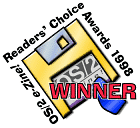
| Home Page
|

|
|
Best Disk / File Utility
|
File Commander is a text mode file manager and shell that allows
you to locate, copy, move, delete, view, edit and execute your files in a
quick, convenient and customizable manner.
Its main display provides dual directory view panels that may serve as source
and destination of a copy or move operation or just two different views of your
files. A panel may also be used to view a directory tree, drive statistics or
may be turned off altogether, making visible the output of previously executed
commands.
A command line is also provided and operates in conjunction with the directory
panels to make it much more powerful than a regular CLI including pasting file
names from the panel, a command history recall window and command completion
from history.
Downloads
Main Features
- Built in archive support including archives inside archives to any depth, with ZIP, ARJ, RAR, LZH, ACE, HA, TAR, GZip, 7ZIP and BZIP2 types currently supported.
- Text mode for speed and other advantages
- Mouse support.
- Full Unicode file name support.
- Full support for large files and volumes (up to 2^63 bytes).
- Online help.
- Many configuration options.
- Colourization of file and directory names by boolean expression.
- Built in file viewer with hex view mode and syntax highlighting.
- Built in editor with undo/redo, syntax highlighting and cut/copy/paste ability using the global clipboard.
- Code page translation function in viewer and editor.
- File Find facility combining wildcard file name filters with file contents scanning.
Allows search/replace of text within matching files.
- Calculation of the total disk usage of a directory tree.
- Tree views for quick and easy directory changes.
- Intelligent execution of the different types of executables supported by
OS/2 or Windows.
- User definable menu including powerful operators such as
- Run a command once for every tagged file.
- Automatically create a file containing a list of tagged files.
- Get input value from the user.
- List all tagged files in the parameter list, automatically running the command multiple
times if the command line gets too long.
- Browsing of network servers & shares.
- Directory history for changing back to recently viewed directories.
- Easy creation of desktop objects.
- Enhanced wildcard handling including boolean operators (and, or, not, brackets) for combining multiple file name masks.
- Flexible file name filtering.
- Support for 4DOS/4OS2 descriptions
- Supports any number of display columns (minimum 80).
- Start DOS programs with session settings (OS/2 only)
For more information, see:


